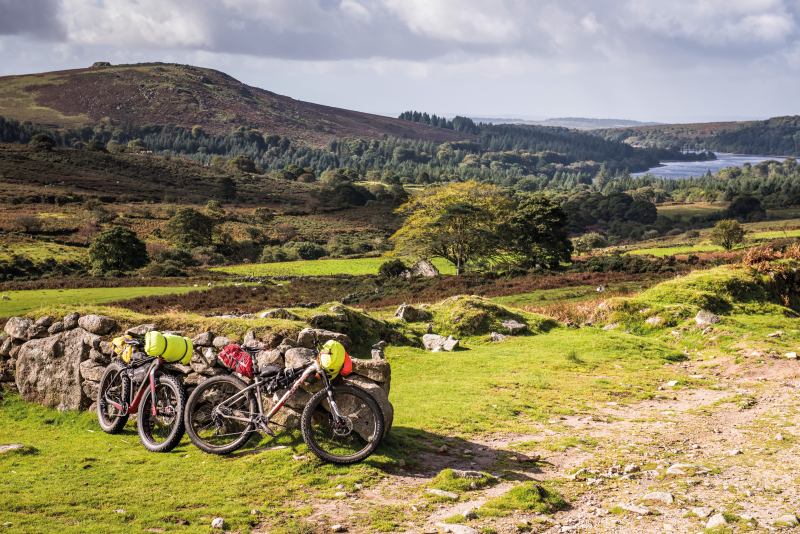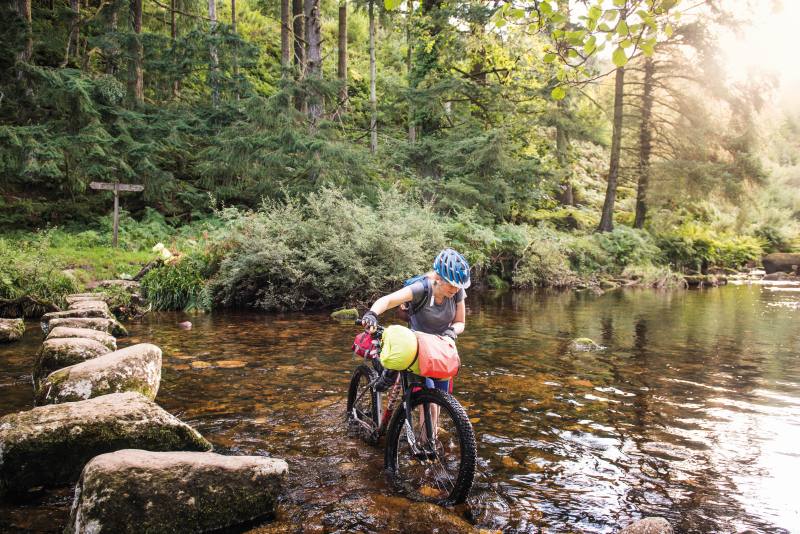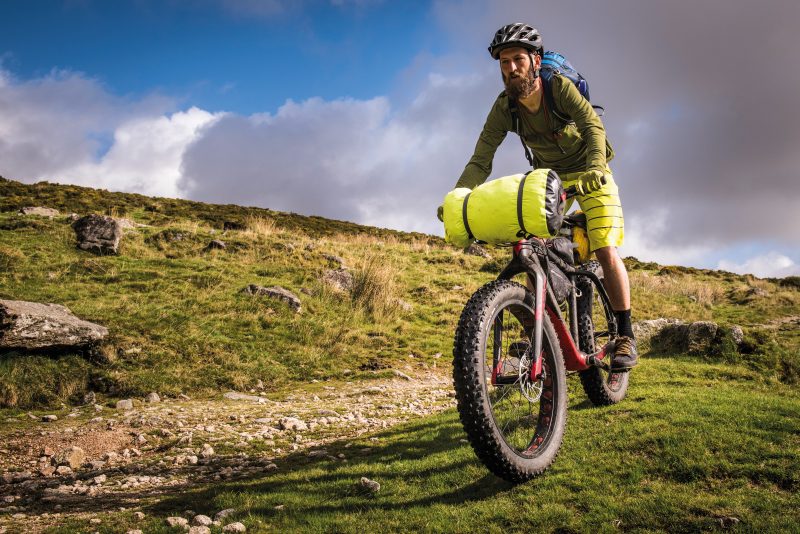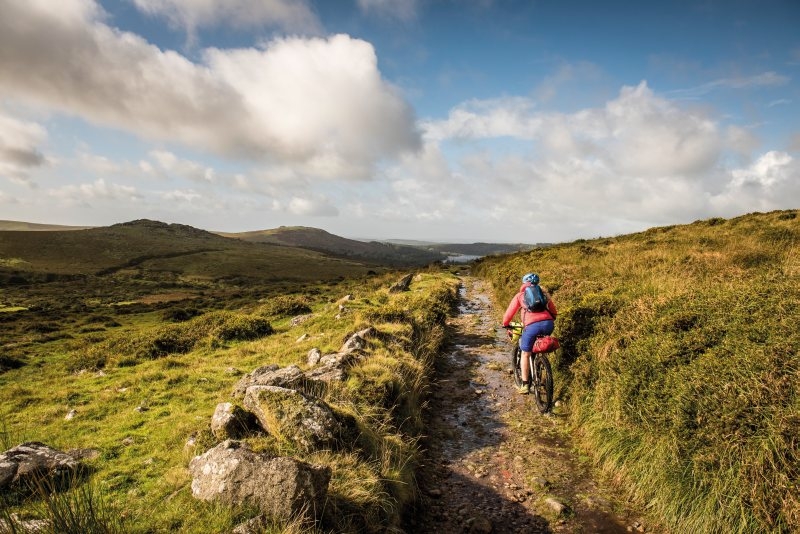- Details
- Written by: Mike Walker
Waking from a near-sleep to the feeling of a daddy-long-legs crawling across my face, I try to bring my hand up to wipe the bug off… only to find the confinement of my sleeping bag and bivvy bag mean I can’t.
What’s more, I’m being soaked by a fine mist rising from the river we’re camped near to. These things ought to add up to a miserable night but as I open my eyes in concern, a meteor streaks across the obscured night sky above, itself a carpet of uncountable twinkling galaxies. An excited whisper to Alice – who is as un-asleep as I am – and within seconds she sees one of her own.
Sleeping in a tent might keep out damp and creepy crawlies, but a night under a tarp lets the magic in.
Dark skies are one of Dartmoor’s greatest assets, which, coupled with Devon’s largest national park’s embrace of wild camping, is why we chose it for a bike packing mini break in the first place. All the same, with hundreds of square miles to choose from, I’m not quite sure why we camped on a river bank......
A veil of mystery hangs over Dartmoor, as impenetrable as the fog which so often shrouds it and likely gave rise to a dozen sinister stories; roaming beasts, hounds of hell and a British Bermuda Triangle await those attempting to cross it if you believe the legends. All of which sound a lark when you’re planning a trip, but somehow loom realistic as you roll out your sleeping bag with not even a tent flap to protect you. We wanted an adventure in which to temporarily lose ourselves, and Dartmoor is more than capable of delivering one.
Bikepacking into the wild
As my girlfriend Alice and I rolled out of the sleepy town of Yelverton in glorious late-summer sun that morning, fog was a distant memory. The western edge of Dartmoor loomed high above us, and it soon became apparent that a significant element of early-Autumn chill was battling against that sun. All said it was a perfect time to set out on a bikepacking adventure; cool enough for pedalling and warm enough to believe we were in the ‘English Riviera’. With the trees on the cusp of a colourful change, it was a sight to behold.
Dartmoor is known as a wild and barren place, but to get there we had to pass through its picturesque and leafy fringes; the dense growth of summer still overhanging the winding lanes en route to Burrator Reservoir. The man-made lake itself is bounded by lush greens but beyond we would find a backdrop of parched moorland, where autumn was taking hold.

First though we rode into Sheepstor village – a settlement which Hollywood could base its entire view of England on; historic and preserved, with its bright red Victorian pillarbox, but nonetheless full of life, with its colourful gardens and overloaded church noticeboard.
At cycling pace the village was behind us all too quickly, but there was little time to lament, as we knew there was plenty ahead. We’d set a very modest goal of around 29km for day one, but being new to the terrain of Dartmoor, the Sonder bikes we were using, and in fact to the very art of bikepacking, we were aiming for ‘achievable’.
All the same, the moors rearing up into the distance were starting to make those 29km look daunting.
We didn’t get properly off road until around Ditsworthy Warren House, which features in the film Warhorse, and a fairly flat run gave me a great first impression of the oversized tyres of the Vir Fortis, Sonder’s carbon fatbike. Despite the dry conditions, the ground was frequently boggy, and the fattie just glided over everything in its path like a juggernaut – including the long uphill slog over Higher Hartor Tor. I was particularly impressed that our not-insignificant luggage didn’t seem to hold us back either.
As we rode, the passing kilometres revealed more about the fanciful fictions and the factual history of Dartmoor, with every few hundred metres revealing evidence of long-gone human activity or beastly legend. Both contributed to the ghost-town feeling, with abandoned and ubiquitous tin mines and ancient settlements interspersed with place names like Piskies (pixies) House, Giant’s Basin and Evil Combe.
Still, it was difficult to feel any kind of unease when the sun was still shining and the trail stretched ahead of us over this beautifully wild landscape.
It wasn’t until after a superb long descent from around Combestone Tor that we encountered something genuinely creepy: the garden gnome-infested Pixieland ‘attraction’. To be fair the sparkly fairy juice we bought from its cafe was refreshing and energy giving, despite being labelled ‘Fanta.’
The landscape was what truly evoked the magic of legend, not the odd tacky tourist attraction, and we found an idyllic example as we traversed the steep banks of the East Dart River after more incredible singletrack down through the woods; a stepping stone river crossing which must have been there for centuries. With the sun beginning to sink we had no desire to get a soaking before sorting our bivvy, so took far too much time gingerly passing the loaded bikes between the stones.

Winding paths through the heavily wooded banks started to become unrideable, with tree roots straight out of Lord of the Rings threatening to become animated and swallow us whole. Arriving at a second stepping-stone crossing, the sun was even lower, dappling through the trees, and again there was magic in the scene.
But by the third such crossing we were kind of over it, and decided these magical crossings were actually a pain in the arse. Nevertheless, we were close to our planned bivvy, with the best singletrack of the day bringing us weary but smiling to the riverside camp that would deliver such a memorable night of spiders and meteors.
A fresh start
By morning the moisture covering us was frozen solid but surprisingly I woke warm anyway. Unfortunately, a complex dance of moving tarps and sleeping bags around patches of sunlight to dry them meant it was two hours before we pedalled out. It seems bike packing has a steep learning curve. Thankfully we had lots of teabags.
A couple of kilometres into our second day and the effect of heavy luggage was starting to show itself; while the bikes had coped admirably, our stamina was not quite where it ought to be, and the flat, boggy expanse of Cator Common drained more strength from our legs than it should. Splashing through the muck was still enough fun on the fattie to spur me into pedalling hard though.
An early lunch of trail mix and foraged blackberries was relaxing enough to turn our minds to shortcuts. We were heading to a high and bleak bivvy by way of the town of Chagford, which seemed a place that was doubly unmissable. Firstly it had been recommended as a quirky quaint town, and more importantly, it was the only place to pick up supplies for dinner.
After a quick descent down to the medieval village of Challacombe – with roaming pigs and not a human in sight – we reached a strip of underused tarmac climbing steadily for miles past wild ponies and highland cattle, with fabulous views as an excuse to stop for a breather.
Country lanes wound steadily downhill for most of the way to Chagford, past stone-built and thatch-roofed farms. Upon arrival the blackberries seemed a long-burnt-off memory and we commenced an entirely decadent cafe crawl through the excellent pies of Blacks Deli and the cappuccinos and hot chocolates of the Birdcage.
We couldn’t help but admire Chagford’s charm; there was a whiff of quirkiness too but a very reserved, British, middle class kind of quirky. A bit like Jennifer Saunders, in fact, who lives there.
We picked up some Tortellini and spent another small fortune in Blacks (we’d need dessert later, naturally...) and began a mega-slog up towards Fernworthy reservoir. As much as I enjoyed gravity taking over on the way down to Chagford, every vertical metre now had to be reclaimed.
The reservoir arrived quicker than expected though – we must have been distracted by the endlessly pretty scenery – and we were soon plunged back into Dartmoor’s netherworld in the Fernworthy Forest, complete with an ancient stone circle casting long shadows from the sinking sun. A reminder that the landscape – as desolate as it was – carried far more history than any old-fashioned village.
We were aiming for the long-abandoned ruins of Teignhead Farm, near Grey Wethers stone circle, and as we emerged above Fernworthy Forest, we were greeted by the most lonely looking place we had encountered so far. The warmth of the sun was blown away by a biting upland wind here, and we instantly understood why the farm had been left to its fate.
We learned later that camping isn’t actually permitted at Teignhead, but that didn’t seem to deter about a dozen Duke of Edinburgh groups from making their way up to join us.
They didn’t disturb our solitude though – we couldn’t even hear them over the sound of the wind howling through the trees. We were under the tarp by 9pm, and I was out again by 10pm to use the loo. At midnight I was urged out again by Alice to check whether branches were about to be blown down on top of us, and from that point sleep was elusive.

The wind in the trees was like a cry of warning that logic couldn’t dispute. Those trees must have stood for hundreds of years, in far wilder storms, but perhaps the dread tales were getting to us. At 2am we finally conceded defeat, and left the tarp to fend for itself while we fumbled in the dark to find what little shelter we could behind a low stone wall.
We were up at 6.30am, and so was the tarp – no sign of fallen trees to spoil its night. I was finally sleeping soundly when the alarm went off, because we had a date. We were meeting Alex Long, who runs Dartmoor Bikepacking and who had been invaluable in helping us put together a route. Our rendezvous was only 2km away – I could almost see it from my bed – so we took our time with porridge and tea, leaving 30 minutes to get there.
Mistake. That mere 2km was a culmination of everything Dartmoor terrain had thrown at us – heavily rutted, relentlessly uphill, lumpy, bumpy and boggy. And the wind was strong enough to turn my handlebars at will. Sleep deprived and having fallen off several times but only slightly late, I suppressed my morning irritation to greet Alex, who instantly cheered me up.
Alex was leading us along the longest, straightest moorland slog of the trip and apparently loving it. It didn’t take too long to get into the rhythm of this terrain, despite my earlier failings, and it was clear that this type of riding was the true character of the moor and the reason Alex can’t keep away; remote, untamed wilderness. The bridleway was a dead-straight line on the map, but in reality was very poorly defined like most of what we had ridden. In comparison to, say the Peak District or Cumbria, these paths are rarely trodden.
The day would be defined by similar routes – difficult to navigate and a test of endurance – through a gunpowder factory and eventually to Conchies Road, which was a very well defined track, having been built by Conscientious Objectors during the First World War. It’s also known as the Road to Nowhere, and seemed an appropriate place to take stock of where our wandering had taken us. We could look to each horizon with the satisfaction that we’d been beyond it.
It was with these thoughts of boundless freedom in mind that Dartmoor Prison loomed into view. The imposing relic of incarceration certainly contrasted with the complete liberation we had enjoyed for three days.

The sight of the prison meant we were entering Princetown, and we said our farewells to Alex over a pint of Jail Ale. Then Alice and I addressed the elephant in the room; with an awful weather forecast, the sleepless previous night, and the fact that the pub had a cheap bunkhouse out back, we barely need to justify ourselves. What felt like copping out turned to immense smugness within 30 minutes of check-in though, as the heavens opened, thoroughly flushed themselves out, and then added a hose-down for good measure. It was the perfect vindication of our decision.
There were no curtains and the bunkroom door wasn’t even attached to its hinges, but none of that stopped us luxuriating in 12 hours of solid sleep.
The morning dawned misty and as grey as the prison that dominated the town, but a short climb on a well-travelled bridleway took us to South Hessary Tor where the cloud was being rapidly burned off by a resurgent sun.
We only had around 13km lined up for our final day, but I was excited; Alex had described the final descent back to Burrator as ‘The Widowmaker’ and its relentless, rattling 7km descent certainly didn’t disappoint.
Even in this popular quarter, Dartmoor’s distinctive character shone through as we passed wild ponies, jaw-dropping scenery and old bridges that appeared to have stood for centuries.
As soon as we hit tarmac, with only a few kilometres to Yelverton, we got another dose of Dartmoor downpour. The timing was astonishing – we were heading for a post-ride pampering at the superb Bedford Hotel in Tavistock, so the soaking only served to make our indulgence feel more deserved. And it would have been fairly bizarre to spend four days in the British wilderness and remain dry.
From our four poster bed, with more of Devon’s history seeping out of the very walls, my thoughts couldn’t help but turn to the stark contrasts of our trip and of Dartmoor itself. A night at the Bedford Hotel might have been our final day’s welcome treat, but it illustrated that you don’t just need soft pillows to feel thoroughly spoiled. The previous night’s luxury was no more than a plastic coated mattress under a roof. The night before that our luxury was a sleeping bag under a fathomless, unobscured canopy of stars. Each was as perfect as the next.
What to take bikepacking on Dartmoor
Bikepacking doesn’t necessarily need a whole new array of specialist kit; whatever bike you have and standard camping kit in a rucksack will get you out there. However, specialist gear will make the experience easier and more fun!
Luggage
Bikepacking luggage which straps onto your bike frame will get weight off your back onto the bike, while preserving handling and allowing you to run a full-suspension mountain bike.
Camping
Lightweight camping gear will boost riding fun, but of equal importance is packsize. To this end we chose Alpkit’s Rig 7 tarp (£80, alpkit.com) and Hunka bivvy bags (£47) over a tent. The 2.4m x 2.8m Rig 7 weighs just 55og, has room for 2, plus luggage, and can even be rigged between bikes if there are no trees.
We also used Alpkit’s titanium non-stick MytiStax cooking pots (£55), MSR’s Pocket Rocket stove, a Sawyer Water Filter, headtorches, camping mats and 3-season down sleeping bags.
Clothing
We rode and camped in lightweight MTB clothing from Ion and Madison, with Alpkit Filoment down jackets (£130), warm leggings and our standard waterproofs.
Our Trip
Our route planning was made possible by the kind input of Alex from Dartmoor Bikepacking, who offers 'soft guiding' through his website at dartmoorbikepacking.com.
The Bedford Hotel in Tavistock made for a thoroughly indulgent post-ride treat, with double rooms from £140 bed and breakfast; bedford-hotel.co.uk
Princetown has a choice of bunk houses for a budget option, and several cosy pubs serving a great range of ales. Campsites and hostels are also dotted around.
For info and assistance on all things Dartmoor, visit visitdartmoor.co.uk




